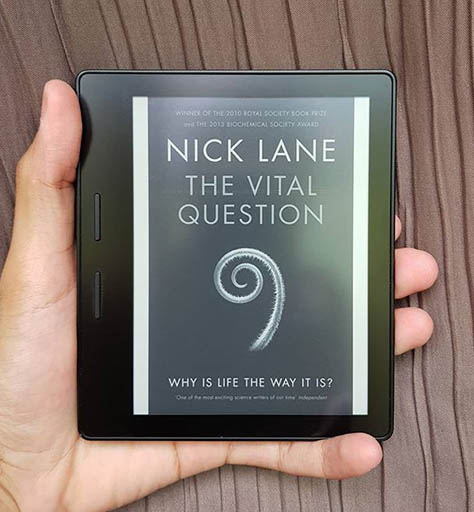Aug 14, 2018 - 4 minutes
📖 The Vital Question by Nick Lane

Rating: 🌕🌕🌕🌗🌑
“Onions, wheat and amoebae have more genes and more DNA than we do."
There’s one question that’s baffled us for as long as we’ve been around, and that is: How did life—complex life, in particular—begin? This book is Nick Lane’s attempt at answering that question.
If not for Bill Gates, I would’ve probably not picked this up. He makes such a good case for it on his personal blog (www.gatesnotes.com), that I was tempted to give it a try. There are very few books that have changed our understanding of biology, and it turns out The Vital Question has the potential of becoming one of them, up there with Darwin’s The Origin of Species and Dawkins’ The Selfish Gene. Having read both of those, it seemed only natural for me to attempt this one. I promised myself to finish it, no matter how challenging it turned out to be. That was, of course, foolish.
As ground-breaking as the ideas in this book are, the writing is dry, except for a few wonderful passages (I’ve shared some below). I had a hard time comprehending major parts of the book. I understood the overall idea, and a few individual concepts, but as a whole, The Vital Question is highly technical, and sort of textbooky. I’m surprised it’s classified as Popular Science. Nick Lane, to his credit, tries his best to simplify things, but the subject itself is so complex that it could hardly be made any simpler by any other writer.
It’s clear, of course, that the problem here lies with me, the reader. I don’t possess a deep enough understanding of biology and chemistry to fully appreciate this book; someone else might. One thing’s for sure, though—I know a little bit more about the origin of life today than I did yesterday, and that’s good enough for me.
Tidbits:
Life, as biochemist Albert Szent-Györgyi observed, is nothing but an electron looking for a place to rest.
Onions, wheat and amoebae have more genes and more DNA than we do. Amphibians such as frogs and salamanders have genome sizes that range over two orders of magnitude, with some salamander genomes being 40 times larger than our own, and some frogs being less than a third of our size. If we had to sum up the architectural constraints on genomes in a single phrase, it would have to be ‘anything goes’.
“The ancient covenant is in pieces; man knows at last that he is alone in the universe’s unfeeling immensity, out of which he emerged only by chance. His destiny is nowhere spelled out, nor is his duty. The kingdom above or the darkness below: it is for him to choose.” - Jacques Monod, 1970
We use about 2 milliwatts of energy per gram – or some 130 watts for an average person weighing 65 kg, a bit more than a standard 100 watt light bulb. That may not sound like a lot, but per gram it is a factor of 10,000 more than the sun (only a tiny fraction of which, at any one moment, is undergoing nuclear fusion). Life is not much like a candle; more of a rocket launcher.
Your 40 trillion cells contain at least a quadrillion mitochondria, with a combined convoluted surface area of about 14,000 square metres; about four football fields. Their job is to pump protons, and together they pump more than 1021 of them – nearly as many as there are stars in the known universe – every second.
…sex introduces the problem of finding a mate, with all its emotional (and financial) costs. And there’s the cost of males. Clone yourself and there’s no need for all those aggressive, prancing males, locking horns, fanning tails or dominating boardrooms.
If totally unconstrained, a single E. coli bacterium, doubling every 30 minutes, would produce a colony with the mass of the earth in three days flat.
These same shuttling electrons and protons have sustained you from the womb: you pump 1021 protons per second, every second, without pause. Your mitochondria were passed on from your mother, in her egg cell, her most precious gift, the gift of living that goes back unbroken, unceasing, generation on generation, to the first stirrings of life in hydrothermal vents, 4 billion years ago.
How lucky that our minds, the most improbable biological machines in the universe, are now a conduit for this restless flow of energy, that we can think about why life is the way it is.
Hi there! 👋 Want to be informed of new posts via email?